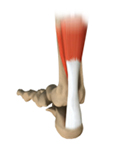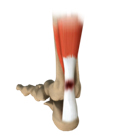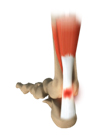
An Achilles tendon is a group of tough fibrous tissue that connects the calf muscles to the heel bone. Itfunctionsso as to elevate the heel while walking or running.
Achilles tendon
The two major problems associated with the Achilles tendon are:
- Achilles tendonitis: refers to the inflammation of the tendon.

- Achilles tendinosis: a condition that originates due to degeneration of the tendon caused by the unresolved inflammation. The tendon develops minute tears or pores in the tissue thereby losingits unique structure.

Sometimes, because of degeneration, an Achilles tendon also tears or ruptures either partially or completely causing pain or loss of movement.
Causes:
Constant overuse or repetitive activities can cause Achilles tendon disorders. These activities exert excessive stress on the tendon and lead to microtears. This damage or injury of the tendon results in pain.
People involved in activities like sports and exercises are more prone to develop Achilles tendon disorders. It is also commonly seen in people whose occupation puts lot of pressure on their feet and ankles. Simple movements like running, jumping, stretching, and improper shoescan also result in rupture of the tendon.
Symptoms:
Symptoms related to Achilles tendon conditions include:
- Swelling and bruising
- Mild or severe pain
- Stiffness
- Loss of strength
- Decreased movements of the ankle
- Muscle weakness or tenderness
- Difficulty in walking or standing
Diagnosis:
Diagnosis is based on the following:
- Medical history
- Physical examination of the foot and ankle to assess the movements and condition of the tendon
- Radiological investigations like foot or ankle X-rays, scans or MRI
Treatment:
Treatment options depend on the duration and extent of injury to the tendon. Mild cases can be treated by the following approaches:
- Get adequate rest.
- Start medications as prescribed by your doctor which help relieve pain and inflammation.
- Apply ice bags over a towel to the affected area for about 15-20 minutes to reduce swelling and inflammation.
- Restrict the activities that cause pain and stress for a short duration.
- Immobilization through the use of a cast, splint, brace, walking boot, or other device which prevents the movements of the leg and assists faster healing of the tendon.
- Physical therapy modalities such as strengthening exercises, massage, ultrasound therapy, stretching, and a walking rehab programhelp to improve range of motion.
Surgery is indicated only in severe cases and depends on the age and activity level of the individual, extent of damage to the tendon, and other factors.
Prevention:
Strictly follow the post-treatment instructions and wear appropriate shoes for the foot type and activity as recommended by your doctor to prevent the recurrence of the condition.
